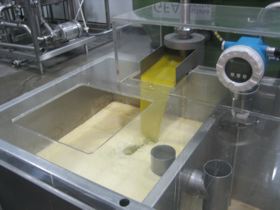
You’re at the grocery store, staring blankly at the shelves of olive oil. It’s almost like looking at shelves full of wine. Intimidating. Confusing. You just want a decent bottle of extra virgin olive oil. Do you choose by label, by country, by price? To make matters even worse, it’s highly likely that bottle of oil you just picked up contains an inferior olive oil that wouldn’t pass a test for extra virgin olive oil. And even though it is labeled “product of Italy” that oil probably came from Spain, Greece, Tunisia, Egypt, Turkey, Syria, Morocco or Argentina.
I went just took a tour of three California olive companies — one olive processor, two olive oil producers. Was organized by the fairly new UC Davis Olive Center at the Robert Mondavi Institute for Wine and Food Science (hey I was at the ground breaking for that center years ago.) The main point of the tour seemed to be enlisting us attendees (about 10 of us chefs/writers/bloggers) in getting the word out about what’s really in a bottle of “extra virgin olive oil.”
I’ve done many TV stories on artisan olive producers in wine country: McEvoy, Round Pond, Pasolivo, The Olive Press. One of the oil producers on the tour was Bozzano Olive Ranch, near Stockton, CA. It’s also a small artisan operation. When we got there they were custom milling oil for a client. It’s fascinating to see olives get separated from leaves and stems, get washed and then milled into paste.
The oil is extracted from the paste, and when it flows out, it’s cloudy (eventually the oil clears up).
Bozzano has two main products, A2 and Toscana, both blends of different olive varietals. It’s sort of similar to wine. The owner told us that only 20% of what’s milled turns into olive oil; the rest is pumice. The olives are also handpicked. Makes you understand the high prices for these artisan oils.
In stark contrast, another stop, Corto Olive in Lodi (wine country) is the second largest olive oil producer in California (and the US) after California Olive Ranch. The milling plant was much bigger, and there are actually two mills working 24-7 during the harvest, which was happening while we were there.
They machine harvest (which we didn’t see) and they say that’s one reason their oils are priced lower, like $7.99 per half liter (compared to Bozzanno at $26/half liter). Corto emphasizes freshness — that oils are stored in temperature controlled tanks topped off with nitrogen to keep oxidation out (hmm sounds like wine), and fill bottles only as orders come in. I’ve been to California Olive Ranch, and they do the same thing. You can find California Olive Ranch at local markets but Corto is a dedicated custom-mill facility and they provide oil for private labels — Sam’s Club and Zabar’s for example. We got to try freshly milled oil — otherwise known at olio nuovo. It’s bright green and cloudy, and the aroma is very grassy. The taste is bitter and grassy — a “three cough oil” for sure. If an oil causes you to cough, that means it’s pretty pungent. I like oils like that! Most Americans go for a softer, fruitier oil.
When you are at the milling line, the whole room smells like olives. Here’s a video of the final oil coming out:
The other stop was at olive processor Musco Family Olive Company, in Tracy. I’ve never thought about black olives and other types of canned/bottled olives and how they get to be that way. But then I never eat black olives. They remind me of the canned sliced mushrooms that pizza places used to use. No flavor or texture. Musco says most Americans prefer the black olives. Well they don’t pick them black, they pick them green. Then they are cured in these cement tanks.
There are about 1300 tanks in the storage yard at Musco. At peak capacity Musco says they process enough olives to give every person in the world 4 olives.
The cured green olives go through an oxidizing process where they turn black (aka ripe). Then they’re pitted and canned. They told us the small green olives, especially the ones stuffed with pimentos, usually are imported from Spain and other countries. Musco uses mostly Manzanilla olives, a Spanish variety.
One cool thing from Musco — they have a olive nutrition chart with calorie counts. The range is from 4 calories for a small olive to 12 calories for a “super colossal” olive.
So if you’re buying olive oil, what to look for? For California oils, the Certified Extra Virgin seal from California Olive Oil Council on the bottle means the oil inside is indeed extra virgin. If you see an oil that says imported from or product of Italy, look at the fine print. The label probably says something like “contains oils from…” a list of countries. There’s no law that governs extra virgin olive oil imports. You can always buy small bottles, and do a taste test. Once you’ve had fresh oil, and true extra virgin oil, other oils made from inferior oils and blends won’t measure up. My advice, eat local. California’s oils are just as good, if not better than some top Italian oils. Also terms like cold press or first press don’t mean much anymore, since most EVO is almost always the first and cold press.
And, finally, what to pair with olives? You need a wine that can cut through the brininess. My choice is bubbly, either a nice California sparkling wine (Iron Horse, Schramsberg, Domaine Carneros or Mumm will do), or a Spanish Cava (Segura Viudas is a good bet).
